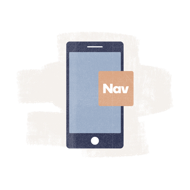Ready for a challenge? Of course you are— you’re a business owner after all. How about a challenge to establish and build business credit in less than two weeks? If you’re like many of the entrepreneurs we work with at Nav, building business credit is a task that’s been on your “to do” list for a while, but you’ve relegated it to the back burner more than once, and it’s simply not getting done.
We’re going to make it easy for you by giving you 12 tasks to accomplish in 12 days. (Or you can space them out and cover them in 24 days— just don’t let them get put on that back burner again!)
While you aren’t going to go from no business credit score to a stellar one in just 12 days, once you’ve checked these items off your list, you should be well on your way to building a positive business credit history.
1. Make Sure Your Business Is Legit
Making sure your business is set up legitimately is the most involved of the steps we’ll describe, but it’s important for a variety of reasons. To build business credit, you need a business. While that may sound obvious, the vast majority of small businesses in the US operate as sole proprietors and many haven’t taken even basic steps to make sure their business looks (and is) legitimate in the eyes of lenders, suppliers and business partners. You may have taken some of these steps already, but if not now’s the time to knock these out.
If possible, establish your business as a separate legal entity (LLC or S Corp, for example). You can build business credit as a sole proprietor but when you operate your business that way you have no legal protection and some lenders recognize that. Plus, there may be significant tax advantages to setting up a legal entity.
Make sure you have a business name that doesn’t infringe on others, or will get mixed up with others— including in credit reports. Also be sure you’ve decided on your business address (even if it’s your home address) and get a business phone number separate from your personal phone number. (Here are some inexpensive business phone number options.) You can use this this checklist to make sure you haven’t overlooked basic steps for making sure your business is legitimate.
2. Check Your Credit Status
Even if you haven’t done a thing to build business credit, your business may already be in the databases of commercial credit agencies. This is particularly true if you have formed a corporate structure or registered your business with your state; that information often makes its way to credit reporting agencies and starts your credit file.
You can check if you are in Experian’s database here; Dun & Bradstreet here (click on company search); and Equifax here.
3. Get a DUNS Number
A DUNS number is an identifier for your business in the Dun & Bradstreet database. If your business does not already have one (your business did not show up in step 2 when you checked D&B’s database), you can get a DUNS number for free. You do not have to register with Experian or Equifax.
4. Review or Pick Your NAICS or SIC Code
A SIC or NAICS code is a code used to identify the type of business you operate. It is important that this information is accurate. Some types of businesses are considered higher risk and some lenders won’t lend to businesses in certain industry categories. If your business already has a business credit report, make sure the SIC or NAICS code listed makes sense.
5. Get a Business Bank Account
This step won’t directly impact your business credit in the short term, as business bank accounts do not typically appear on credit reports. However, it will help you in the long run. Having a business bank account may help you qualify for business loans or financing in the future, as some lenders will require you to submit business bank account statements and will review your business cash flow when evaluating your application. And if you do get that financing, it may appear on your credit reports and help build credit.
6. Get a Business Credit Card
A business credit card will allow you to separate business and personal purchases, but more importantly, should give you a positive business credit reference if paid on time. This guide explains how major credit card issuers report to commercial credit agencies.
Some small business owners are surprised to learn that it is possible to get a business credit card even when their business is new. Usually these applications are evaluated on the basis of the owner’s personal credit scores, not the credit score of the business. As long as you have good personal credit and sufficient income (from all sources), you should be able to get one.
7. Set up Autopay for Your Business Credit Card
Paying your bills on time is crucial to building good credit and it’s even more important with business credit since some business credit scores are based almost entirely on payment history. So don’t let a bill slip through the cracks and hurt your credit. Set up automatic payments for your account, even if it’s just to make sure the minimum payment gets paid on time each month.
8. Get Your First Vendor Account
Vendors are companies that offer supplies your company needs, such as shipping boxes, cleaning supplies, printer ink, etc. Some vendors offer net-30 terms to business customers, which means the bill must be paid within 30 days of the invoice date. If you establish an account on terms with a vendor that reports that payment history to commercial credit bureaus, you’ll help build your business credit— provided you pay on time of course! Here are three vendors that can help you build business credit.
Note: If your business is brand new and you don’t have a business credit history, some vendors may require you to purchase and pay for an order in full before they will extend terms.
9. Get Your Second Vendor Account
Now that you have one account under your belt, you’ll want to establish a second one. Applying for numerous accounts in a short period of time can backfire on you if the lender is relying on personal credit. That’s because personal credit reports list an “inquiry” every time your personal credit is checked, and each one can lower your credit scores by a few points. But business credit inquiries are not as much of a concern; typically they don’t even matter. You’re going to need a few accounts to establish business credit, so go ahead and get a second one.
10. Get Your Third Vendor Account
You’ll need three accounts reporting to Dun & Bradstreet for a D&B Paydex score to be created. If your business credit card does not report to them, you’ll need a third account to complete the process. Go ahead get a third vendor account and buy items your business needs from each one of them in order to start establishing activity and a payment history.
11. Schedule Payments for All 3 Vendor Accounts
As we mentioned earlier, the most important thing you can do to build strong business credit is to pay all of your business accounts that report on time. (Early is even better.) It may be harder to automate vendor accounts, as compared to credit card accounts, but you may be able to set up online payments from your business bank account. If not, put a reminder on your calendar to make sure the payment is made on time. If you pay by mail, allow at least seven days to ensure it is received before the due date. Business credit reports will note if a payment is even a day or two late.
12. Set Up Monitoring for Your Business & Personal Credit
Congrats if you’ve made it through all 12 steps! You’ll now want to monitor your progress. It may be a couple of months before your new business credit card and vendor accounts show up on your business credit reports, so start monitoring your reports on a monthly basis to see when they appear. If they don’t show up in sixty days or so, contact those lenders and/or vendors to see if you can find out why they aren’t reporting.
You can purchase credit monitoring from the major commercial credit reporting agencies or get an account with Nav, where you can monitor business and personal credit. (A standard Nav account is free; paid accounts provide additional information for a fee.)
As a bonus, Nav’s latest research showed that business owners who regularly used its platform increased their Dun & Bradstreet PAYDEX score by 12 points.
This article was originally written on January 17, 2018 and updated on January 30, 2020.



Have at it! We'd love to hear from you and encourage a lively discussion among our users. Please help us keep our site clean and protect yourself. Refrain from posting overtly promotional content, and avoid disclosing personal information such as bank account or phone numbers.
Reviews Disclosure: The responses below are not provided or commissioned by the credit card, financing and service companies that appear on this site. Responses have not been reviewed, approved or otherwise endorsed by the credit card, financing and service companies and it is not their responsibility to ensure all posts and/or questions are answered.